Impacts of Healthy Soil on Climate Change and Productivity
VerifiedAdded on 2022/10/11
|19
|7040
|21
Report
AI Summary
This report, authored by Hassan Ghafaripalangari, delves into the critical role of healthy soil in mitigating climate change and enhancing agricultural productivity. The introduction establishes soil as a vital ecosystem, emphasizing the significance of Soil Organic Carbon (SOC) and its impact on soil fertility and plant growth. The report investigates the research aims and objectives, focusing on the relationship between soil health, climate change, and agricultural yield. It explores the research strategy, including the research onion, philosophy, and approach. Data analysis findings are presented, followed by a discussion and conclusion that highlights the importance of soil carbon sequestration, crop rotation, and sustainable agricultural practices in addressing environmental challenges and promoting food security. The report also touches upon the impacts of climate change on soil erosion and the need for multidisciplinary collaboration to achieve sustainable agricultural methods. The student's work includes references and a detailed exploration of soil health's influence on the environment and economy.
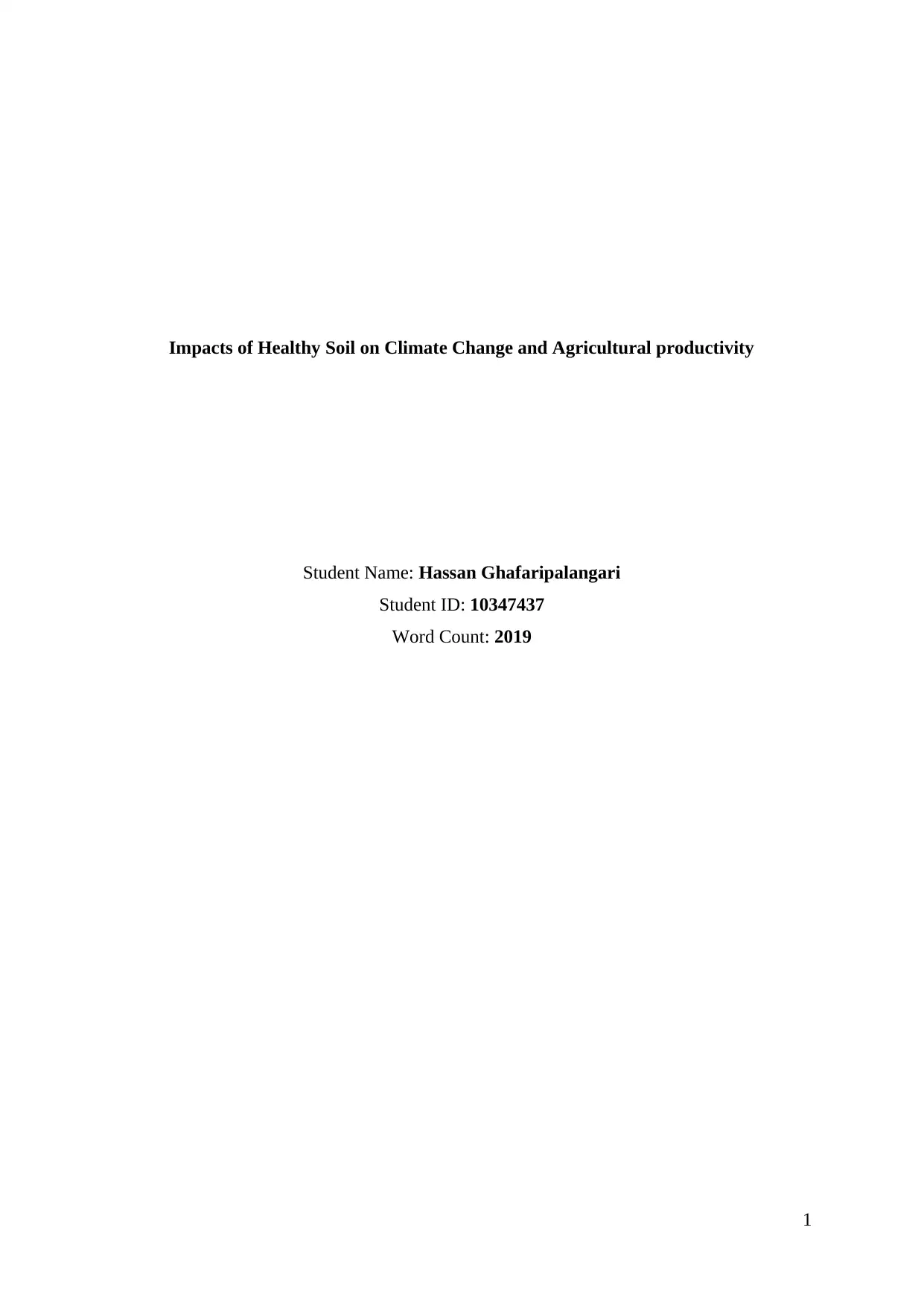
Impacts of Healthy Soil on Climate Change and Agricultural productivity
Student Name: Hassan Ghafaripalangari
Student ID: 10347437
Word Count: 2019
1
Student Name: Hassan Ghafaripalangari
Student ID: 10347437
Word Count: 2019
1
Paraphrase This Document
Need a fresh take? Get an instant paraphrase of this document with our AI Paraphraser
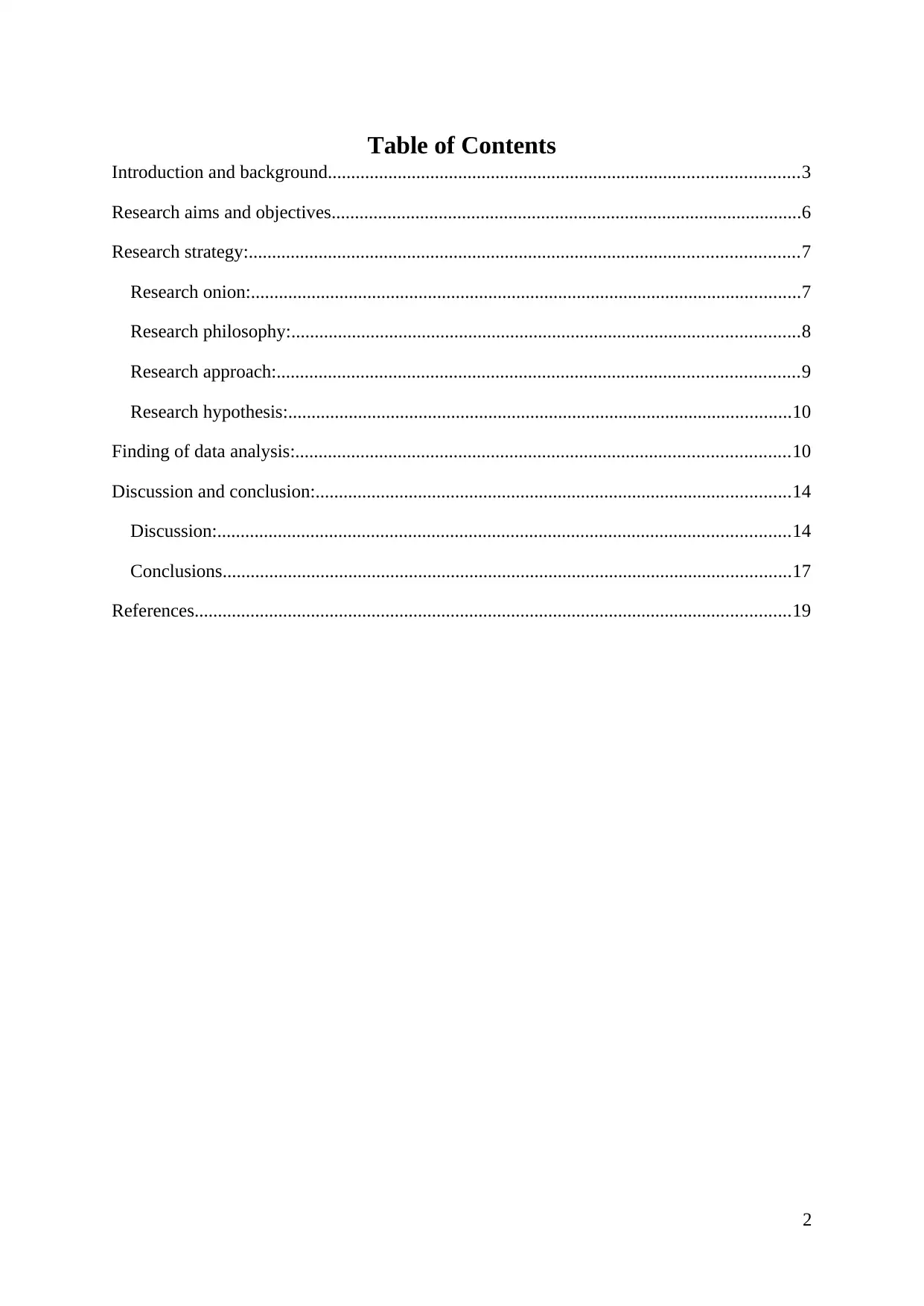
Table of Contents
Introduction and background.....................................................................................................3
Research aims and objectives.....................................................................................................6
Research strategy:......................................................................................................................7
Research onion:......................................................................................................................7
Research philosophy:.............................................................................................................8
Research approach:................................................................................................................9
Research hypothesis:............................................................................................................10
Finding of data analysis:..........................................................................................................10
Discussion and conclusion:......................................................................................................14
Discussion:...........................................................................................................................14
Conclusions..........................................................................................................................17
References................................................................................................................................19
2
Introduction and background.....................................................................................................3
Research aims and objectives.....................................................................................................6
Research strategy:......................................................................................................................7
Research onion:......................................................................................................................7
Research philosophy:.............................................................................................................8
Research approach:................................................................................................................9
Research hypothesis:............................................................................................................10
Finding of data analysis:..........................................................................................................10
Discussion and conclusion:......................................................................................................14
Discussion:...........................................................................................................................14
Conclusions..........................................................................................................................17
References................................................................................................................................19
2
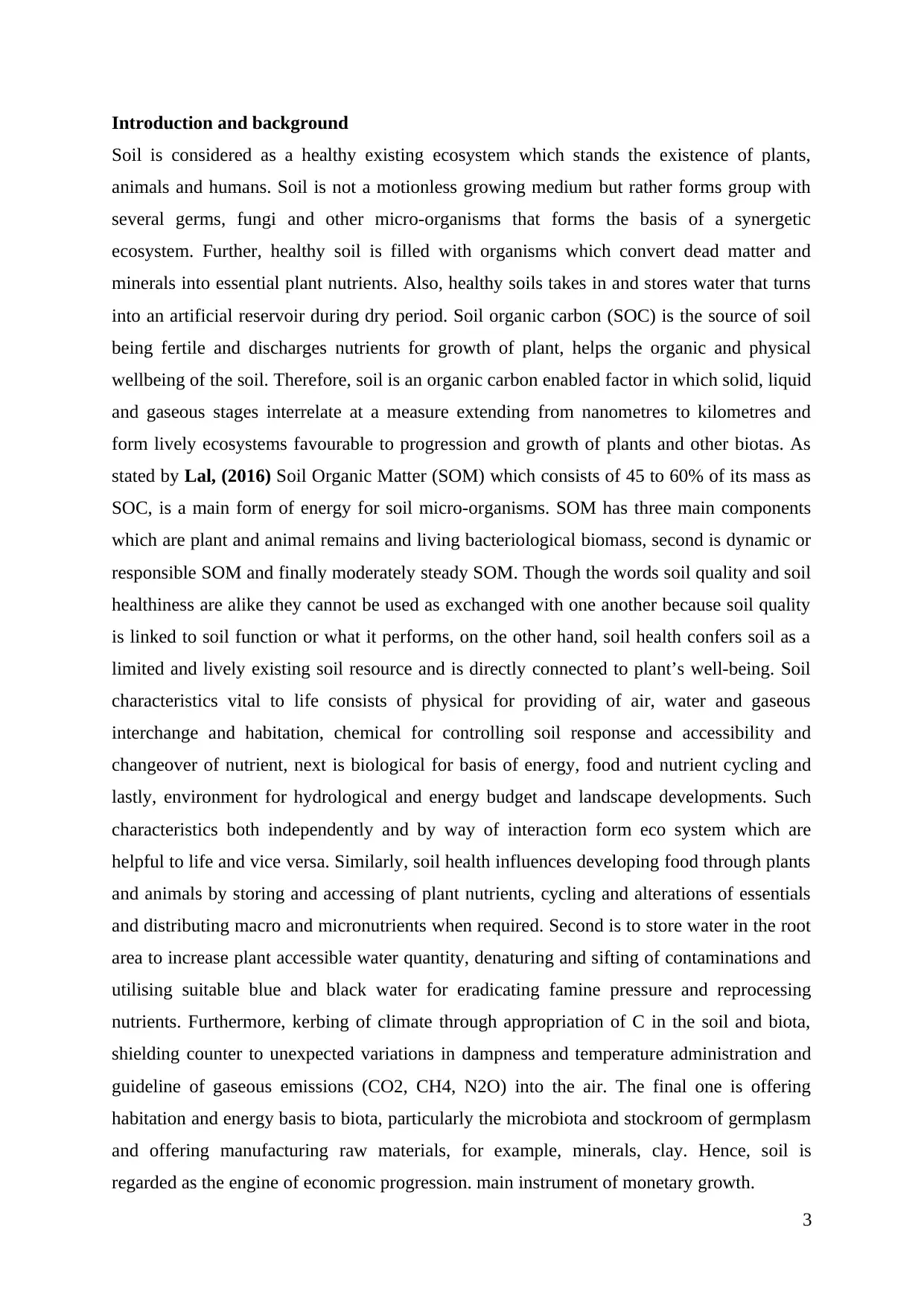
Introduction and background
Soil is considered as a healthy existing ecosystem which stands the existence of plants,
animals and humans. Soil is not a motionless growing medium but rather forms group with
several germs, fungi and other micro-organisms that forms the basis of a synergetic
ecosystem. Further, healthy soil is filled with organisms which convert dead matter and
minerals into essential plant nutrients. Also, healthy soils takes in and stores water that turns
into an artificial reservoir during dry period. Soil organic carbon (SOC) is the source of soil
being fertile and discharges nutrients for growth of plant, helps the organic and physical
wellbeing of the soil. Therefore, soil is an organic carbon enabled factor in which solid, liquid
and gaseous stages interrelate at a measure extending from nanometres to kilometres and
form lively ecosystems favourable to progression and growth of plants and other biotas. As
stated by Lal, (2016) Soil Organic Matter (SOM) which consists of 45 to 60% of its mass as
SOC, is a main form of energy for soil micro-organisms. SOM has three main components
which are plant and animal remains and living bacteriological biomass, second is dynamic or
responsible SOM and finally moderately steady SOM. Though the words soil quality and soil
healthiness are alike they cannot be used as exchanged with one another because soil quality
is linked to soil function or what it performs, on the other hand, soil health confers soil as a
limited and lively existing soil resource and is directly connected to plant’s well-being. Soil
characteristics vital to life consists of physical for providing of air, water and gaseous
interchange and habitation, chemical for controlling soil response and accessibility and
changeover of nutrient, next is biological for basis of energy, food and nutrient cycling and
lastly, environment for hydrological and energy budget and landscape developments. Such
characteristics both independently and by way of interaction form eco system which are
helpful to life and vice versa. Similarly, soil health influences developing food through plants
and animals by storing and accessing of plant nutrients, cycling and alterations of essentials
and distributing macro and micronutrients when required. Second is to store water in the root
area to increase plant accessible water quantity, denaturing and sifting of contaminations and
utilising suitable blue and black water for eradicating famine pressure and reprocessing
nutrients. Furthermore, kerbing of climate through appropriation of C in the soil and biota,
shielding counter to unexpected variations in dampness and temperature administration and
guideline of gaseous emissions (CO2, CH4, N2O) into the air. The final one is offering
habitation and energy basis to biota, particularly the microbiota and stockroom of germplasm
and offering manufacturing raw materials, for example, minerals, clay. Hence, soil is
regarded as the engine of economic progression. main instrument of monetary growth.
3
Soil is considered as a healthy existing ecosystem which stands the existence of plants,
animals and humans. Soil is not a motionless growing medium but rather forms group with
several germs, fungi and other micro-organisms that forms the basis of a synergetic
ecosystem. Further, healthy soil is filled with organisms which convert dead matter and
minerals into essential plant nutrients. Also, healthy soils takes in and stores water that turns
into an artificial reservoir during dry period. Soil organic carbon (SOC) is the source of soil
being fertile and discharges nutrients for growth of plant, helps the organic and physical
wellbeing of the soil. Therefore, soil is an organic carbon enabled factor in which solid, liquid
and gaseous stages interrelate at a measure extending from nanometres to kilometres and
form lively ecosystems favourable to progression and growth of plants and other biotas. As
stated by Lal, (2016) Soil Organic Matter (SOM) which consists of 45 to 60% of its mass as
SOC, is a main form of energy for soil micro-organisms. SOM has three main components
which are plant and animal remains and living bacteriological biomass, second is dynamic or
responsible SOM and finally moderately steady SOM. Though the words soil quality and soil
healthiness are alike they cannot be used as exchanged with one another because soil quality
is linked to soil function or what it performs, on the other hand, soil health confers soil as a
limited and lively existing soil resource and is directly connected to plant’s well-being. Soil
characteristics vital to life consists of physical for providing of air, water and gaseous
interchange and habitation, chemical for controlling soil response and accessibility and
changeover of nutrient, next is biological for basis of energy, food and nutrient cycling and
lastly, environment for hydrological and energy budget and landscape developments. Such
characteristics both independently and by way of interaction form eco system which are
helpful to life and vice versa. Similarly, soil health influences developing food through plants
and animals by storing and accessing of plant nutrients, cycling and alterations of essentials
and distributing macro and micronutrients when required. Second is to store water in the root
area to increase plant accessible water quantity, denaturing and sifting of contaminations and
utilising suitable blue and black water for eradicating famine pressure and reprocessing
nutrients. Furthermore, kerbing of climate through appropriation of C in the soil and biota,
shielding counter to unexpected variations in dampness and temperature administration and
guideline of gaseous emissions (CO2, CH4, N2O) into the air. The final one is offering
habitation and energy basis to biota, particularly the microbiota and stockroom of germplasm
and offering manufacturing raw materials, for example, minerals, clay. Hence, soil is
regarded as the engine of economic progression. main instrument of monetary growth.
3
⊘ This is a preview!⊘
Do you want full access?
Subscribe today to unlock all pages.

Trusted by 1+ million students worldwide
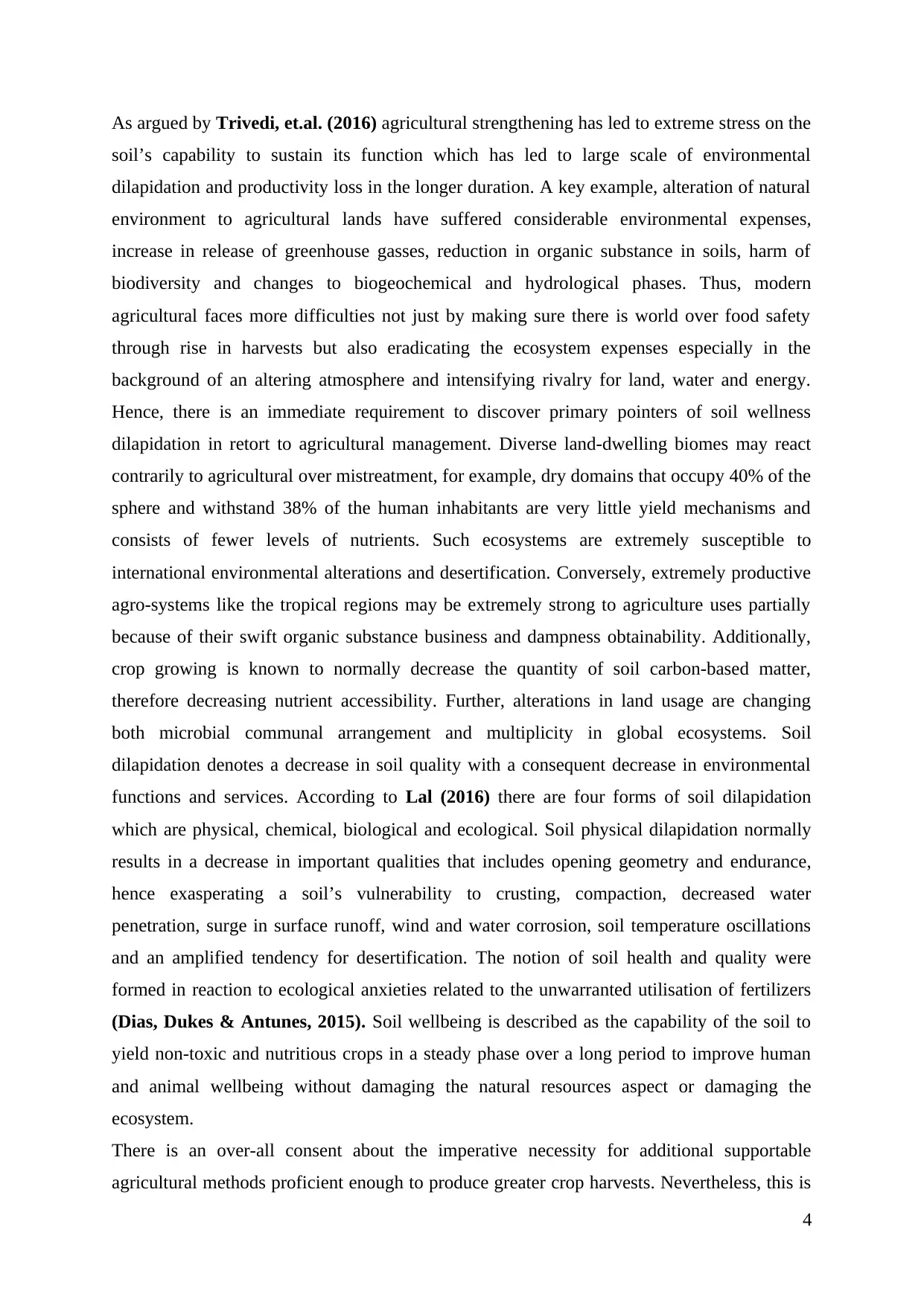
As argued by Trivedi, et.al. (2016) agricultural strengthening has led to extreme stress on the
soil’s capability to sustain its function which has led to large scale of environmental
dilapidation and productivity loss in the longer duration. A key example, alteration of natural
environment to agricultural lands have suffered considerable environmental expenses,
increase in release of greenhouse gasses, reduction in organic substance in soils, harm of
biodiversity and changes to biogeochemical and hydrological phases. Thus, modern
agricultural faces more difficulties not just by making sure there is world over food safety
through rise in harvests but also eradicating the ecosystem expenses especially in the
background of an altering atmosphere and intensifying rivalry for land, water and energy.
Hence, there is an immediate requirement to discover primary pointers of soil wellness
dilapidation in retort to agricultural management. Diverse land-dwelling biomes may react
contrarily to agricultural over mistreatment, for example, dry domains that occupy 40% of the
sphere and withstand 38% of the human inhabitants are very little yield mechanisms and
consists of fewer levels of nutrients. Such ecosystems are extremely susceptible to
international environmental alterations and desertification. Conversely, extremely productive
agro-systems like the tropical regions may be extremely strong to agriculture uses partially
because of their swift organic substance business and dampness obtainability. Additionally,
crop growing is known to normally decrease the quantity of soil carbon-based matter,
therefore decreasing nutrient accessibility. Further, alterations in land usage are changing
both microbial communal arrangement and multiplicity in global ecosystems. Soil
dilapidation denotes a decrease in soil quality with a consequent decrease in environmental
functions and services. According to Lal (2016) there are four forms of soil dilapidation
which are physical, chemical, biological and ecological. Soil physical dilapidation normally
results in a decrease in important qualities that includes opening geometry and endurance,
hence exasperating a soil’s vulnerability to crusting, compaction, decreased water
penetration, surge in surface runoff, wind and water corrosion, soil temperature oscillations
and an amplified tendency for desertification. The notion of soil health and quality were
formed in reaction to ecological anxieties related to the unwarranted utilisation of fertilizers
(Dias, Dukes & Antunes, 2015). Soil wellbeing is described as the capability of the soil to
yield non-toxic and nutritious crops in a steady phase over a long period to improve human
and animal wellbeing without damaging the natural resources aspect or damaging the
ecosystem.
There is an over-all consent about the imperative necessity for additional supportable
agricultural methods proficient enough to produce greater crop harvests. Nevertheless, this is
4
soil’s capability to sustain its function which has led to large scale of environmental
dilapidation and productivity loss in the longer duration. A key example, alteration of natural
environment to agricultural lands have suffered considerable environmental expenses,
increase in release of greenhouse gasses, reduction in organic substance in soils, harm of
biodiversity and changes to biogeochemical and hydrological phases. Thus, modern
agricultural faces more difficulties not just by making sure there is world over food safety
through rise in harvests but also eradicating the ecosystem expenses especially in the
background of an altering atmosphere and intensifying rivalry for land, water and energy.
Hence, there is an immediate requirement to discover primary pointers of soil wellness
dilapidation in retort to agricultural management. Diverse land-dwelling biomes may react
contrarily to agricultural over mistreatment, for example, dry domains that occupy 40% of the
sphere and withstand 38% of the human inhabitants are very little yield mechanisms and
consists of fewer levels of nutrients. Such ecosystems are extremely susceptible to
international environmental alterations and desertification. Conversely, extremely productive
agro-systems like the tropical regions may be extremely strong to agriculture uses partially
because of their swift organic substance business and dampness obtainability. Additionally,
crop growing is known to normally decrease the quantity of soil carbon-based matter,
therefore decreasing nutrient accessibility. Further, alterations in land usage are changing
both microbial communal arrangement and multiplicity in global ecosystems. Soil
dilapidation denotes a decrease in soil quality with a consequent decrease in environmental
functions and services. According to Lal (2016) there are four forms of soil dilapidation
which are physical, chemical, biological and ecological. Soil physical dilapidation normally
results in a decrease in important qualities that includes opening geometry and endurance,
hence exasperating a soil’s vulnerability to crusting, compaction, decreased water
penetration, surge in surface runoff, wind and water corrosion, soil temperature oscillations
and an amplified tendency for desertification. The notion of soil health and quality were
formed in reaction to ecological anxieties related to the unwarranted utilisation of fertilizers
(Dias, Dukes & Antunes, 2015). Soil wellbeing is described as the capability of the soil to
yield non-toxic and nutritious crops in a steady phase over a long period to improve human
and animal wellbeing without damaging the natural resources aspect or damaging the
ecosystem.
There is an over-all consent about the imperative necessity for additional supportable
agricultural methods proficient enough to produce greater crop harvests. Nevertheless, this is
4
Paraphrase This Document
Need a fresh take? Get an instant paraphrase of this document with our AI Paraphraser
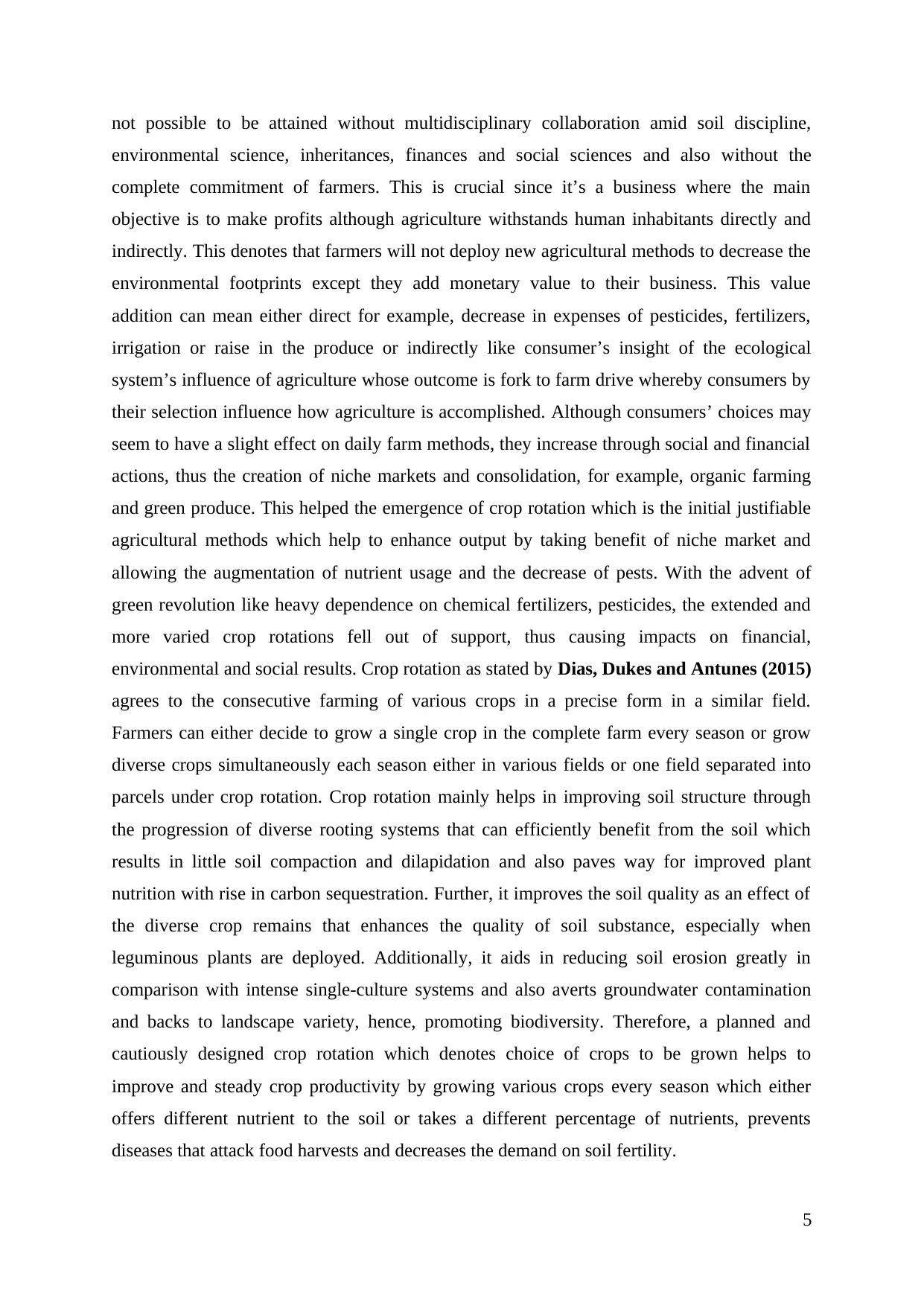
not possible to be attained without multidisciplinary collaboration amid soil discipline,
environmental science, inheritances, finances and social sciences and also without the
complete commitment of farmers. This is crucial since it’s a business where the main
objective is to make profits although agriculture withstands human inhabitants directly and
indirectly. This denotes that farmers will not deploy new agricultural methods to decrease the
environmental footprints except they add monetary value to their business. This value
addition can mean either direct for example, decrease in expenses of pesticides, fertilizers,
irrigation or raise in the produce or indirectly like consumer’s insight of the ecological
system’s influence of agriculture whose outcome is fork to farm drive whereby consumers by
their selection influence how agriculture is accomplished. Although consumers’ choices may
seem to have a slight effect on daily farm methods, they increase through social and financial
actions, thus the creation of niche markets and consolidation, for example, organic farming
and green produce. This helped the emergence of crop rotation which is the initial justifiable
agricultural methods which help to enhance output by taking benefit of niche market and
allowing the augmentation of nutrient usage and the decrease of pests. With the advent of
green revolution like heavy dependence on chemical fertilizers, pesticides, the extended and
more varied crop rotations fell out of support, thus causing impacts on financial,
environmental and social results. Crop rotation as stated by Dias, Dukes and Antunes (2015)
agrees to the consecutive farming of various crops in a precise form in a similar field.
Farmers can either decide to grow a single crop in the complete farm every season or grow
diverse crops simultaneously each season either in various fields or one field separated into
parcels under crop rotation. Crop rotation mainly helps in improving soil structure through
the progression of diverse rooting systems that can efficiently benefit from the soil which
results in little soil compaction and dilapidation and also paves way for improved plant
nutrition with rise in carbon sequestration. Further, it improves the soil quality as an effect of
the diverse crop remains that enhances the quality of soil substance, especially when
leguminous plants are deployed. Additionally, it aids in reducing soil erosion greatly in
comparison with intense single-culture systems and also averts groundwater contamination
and backs to landscape variety, hence, promoting biodiversity. Therefore, a planned and
cautiously designed crop rotation which denotes choice of crops to be grown helps to
improve and steady crop productivity by growing various crops every season which either
offers different nutrient to the soil or takes a different percentage of nutrients, prevents
diseases that attack food harvests and decreases the demand on soil fertility.
5
environmental science, inheritances, finances and social sciences and also without the
complete commitment of farmers. This is crucial since it’s a business where the main
objective is to make profits although agriculture withstands human inhabitants directly and
indirectly. This denotes that farmers will not deploy new agricultural methods to decrease the
environmental footprints except they add monetary value to their business. This value
addition can mean either direct for example, decrease in expenses of pesticides, fertilizers,
irrigation or raise in the produce or indirectly like consumer’s insight of the ecological
system’s influence of agriculture whose outcome is fork to farm drive whereby consumers by
their selection influence how agriculture is accomplished. Although consumers’ choices may
seem to have a slight effect on daily farm methods, they increase through social and financial
actions, thus the creation of niche markets and consolidation, for example, organic farming
and green produce. This helped the emergence of crop rotation which is the initial justifiable
agricultural methods which help to enhance output by taking benefit of niche market and
allowing the augmentation of nutrient usage and the decrease of pests. With the advent of
green revolution like heavy dependence on chemical fertilizers, pesticides, the extended and
more varied crop rotations fell out of support, thus causing impacts on financial,
environmental and social results. Crop rotation as stated by Dias, Dukes and Antunes (2015)
agrees to the consecutive farming of various crops in a precise form in a similar field.
Farmers can either decide to grow a single crop in the complete farm every season or grow
diverse crops simultaneously each season either in various fields or one field separated into
parcels under crop rotation. Crop rotation mainly helps in improving soil structure through
the progression of diverse rooting systems that can efficiently benefit from the soil which
results in little soil compaction and dilapidation and also paves way for improved plant
nutrition with rise in carbon sequestration. Further, it improves the soil quality as an effect of
the diverse crop remains that enhances the quality of soil substance, especially when
leguminous plants are deployed. Additionally, it aids in reducing soil erosion greatly in
comparison with intense single-culture systems and also averts groundwater contamination
and backs to landscape variety, hence, promoting biodiversity. Therefore, a planned and
cautiously designed crop rotation which denotes choice of crops to be grown helps to
improve and steady crop productivity by growing various crops every season which either
offers different nutrient to the soil or takes a different percentage of nutrients, prevents
diseases that attack food harvests and decreases the demand on soil fertility.
5
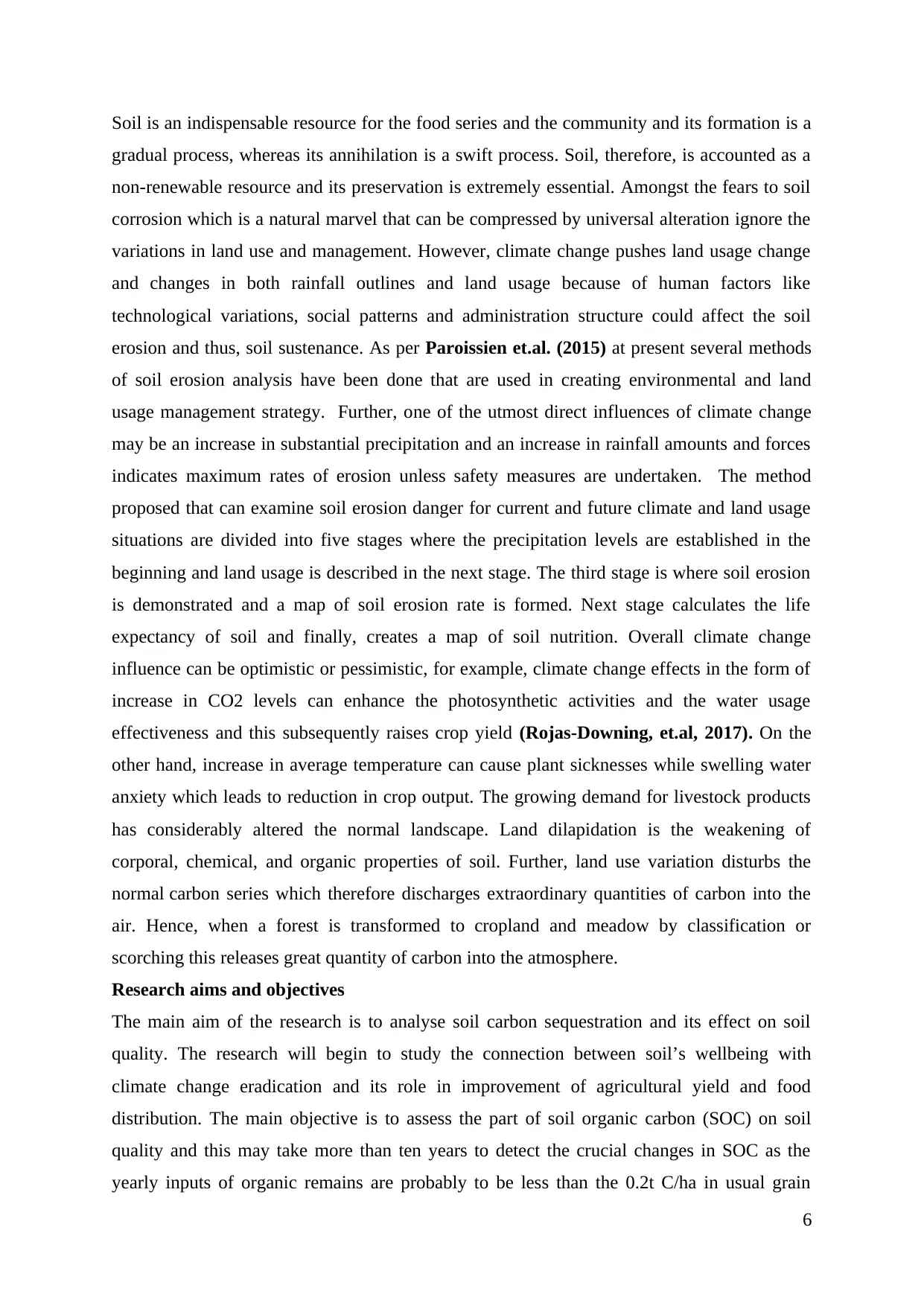
Soil is an indispensable resource for the food series and the community and its formation is a
gradual process, whereas its annihilation is a swift process. Soil, therefore, is accounted as a
non-renewable resource and its preservation is extremely essential. Amongst the fears to soil
corrosion which is a natural marvel that can be compressed by universal alteration ignore the
variations in land use and management. However, climate change pushes land usage change
and changes in both rainfall outlines and land usage because of human factors like
technological variations, social patterns and administration structure could affect the soil
erosion and thus, soil sustenance. As per Paroissien et.al. (2015) at present several methods
of soil erosion analysis have been done that are used in creating environmental and land
usage management strategy. Further, one of the utmost direct influences of climate change
may be an increase in substantial precipitation and an increase in rainfall amounts and forces
indicates maximum rates of erosion unless safety measures are undertaken. The method
proposed that can examine soil erosion danger for current and future climate and land usage
situations are divided into five stages where the precipitation levels are established in the
beginning and land usage is described in the next stage. The third stage is where soil erosion
is demonstrated and a map of soil erosion rate is formed. Next stage calculates the life
expectancy of soil and finally, creates a map of soil nutrition. Overall climate change
influence can be optimistic or pessimistic, for example, climate change effects in the form of
increase in CO2 levels can enhance the photosynthetic activities and the water usage
effectiveness and this subsequently raises crop yield (Rojas-Downing, et.al, 2017). On the
other hand, increase in average temperature can cause plant sicknesses while swelling water
anxiety which leads to reduction in crop output. The growing demand for livestock products
has considerably altered the normal landscape. Land dilapidation is the weakening of
corporal, chemical, and organic properties of soil. Further, land use variation disturbs the
normal carbon series which therefore discharges extraordinary quantities of carbon into the
air. Hence, when a forest is transformed to cropland and meadow by classification or
scorching this releases great quantity of carbon into the atmosphere.
Research aims and objectives
The main aim of the research is to analyse soil carbon sequestration and its effect on soil
quality. The research will begin to study the connection between soil’s wellbeing with
climate change eradication and its role in improvement of agricultural yield and food
distribution. The main objective is to assess the part of soil organic carbon (SOC) on soil
quality and this may take more than ten years to detect the crucial changes in SOC as the
yearly inputs of organic remains are probably to be less than the 0.2t C/ha in usual grain
6
gradual process, whereas its annihilation is a swift process. Soil, therefore, is accounted as a
non-renewable resource and its preservation is extremely essential. Amongst the fears to soil
corrosion which is a natural marvel that can be compressed by universal alteration ignore the
variations in land use and management. However, climate change pushes land usage change
and changes in both rainfall outlines and land usage because of human factors like
technological variations, social patterns and administration structure could affect the soil
erosion and thus, soil sustenance. As per Paroissien et.al. (2015) at present several methods
of soil erosion analysis have been done that are used in creating environmental and land
usage management strategy. Further, one of the utmost direct influences of climate change
may be an increase in substantial precipitation and an increase in rainfall amounts and forces
indicates maximum rates of erosion unless safety measures are undertaken. The method
proposed that can examine soil erosion danger for current and future climate and land usage
situations are divided into five stages where the precipitation levels are established in the
beginning and land usage is described in the next stage. The third stage is where soil erosion
is demonstrated and a map of soil erosion rate is formed. Next stage calculates the life
expectancy of soil and finally, creates a map of soil nutrition. Overall climate change
influence can be optimistic or pessimistic, for example, climate change effects in the form of
increase in CO2 levels can enhance the photosynthetic activities and the water usage
effectiveness and this subsequently raises crop yield (Rojas-Downing, et.al, 2017). On the
other hand, increase in average temperature can cause plant sicknesses while swelling water
anxiety which leads to reduction in crop output. The growing demand for livestock products
has considerably altered the normal landscape. Land dilapidation is the weakening of
corporal, chemical, and organic properties of soil. Further, land use variation disturbs the
normal carbon series which therefore discharges extraordinary quantities of carbon into the
air. Hence, when a forest is transformed to cropland and meadow by classification or
scorching this releases great quantity of carbon into the atmosphere.
Research aims and objectives
The main aim of the research is to analyse soil carbon sequestration and its effect on soil
quality. The research will begin to study the connection between soil’s wellbeing with
climate change eradication and its role in improvement of agricultural yield and food
distribution. The main objective is to assess the part of soil organic carbon (SOC) on soil
quality and this may take more than ten years to detect the crucial changes in SOC as the
yearly inputs of organic remains are probably to be less than the 0.2t C/ha in usual grain
6
⊘ This is a preview!⊘
Do you want full access?
Subscribe today to unlock all pages.

Trusted by 1+ million students worldwide
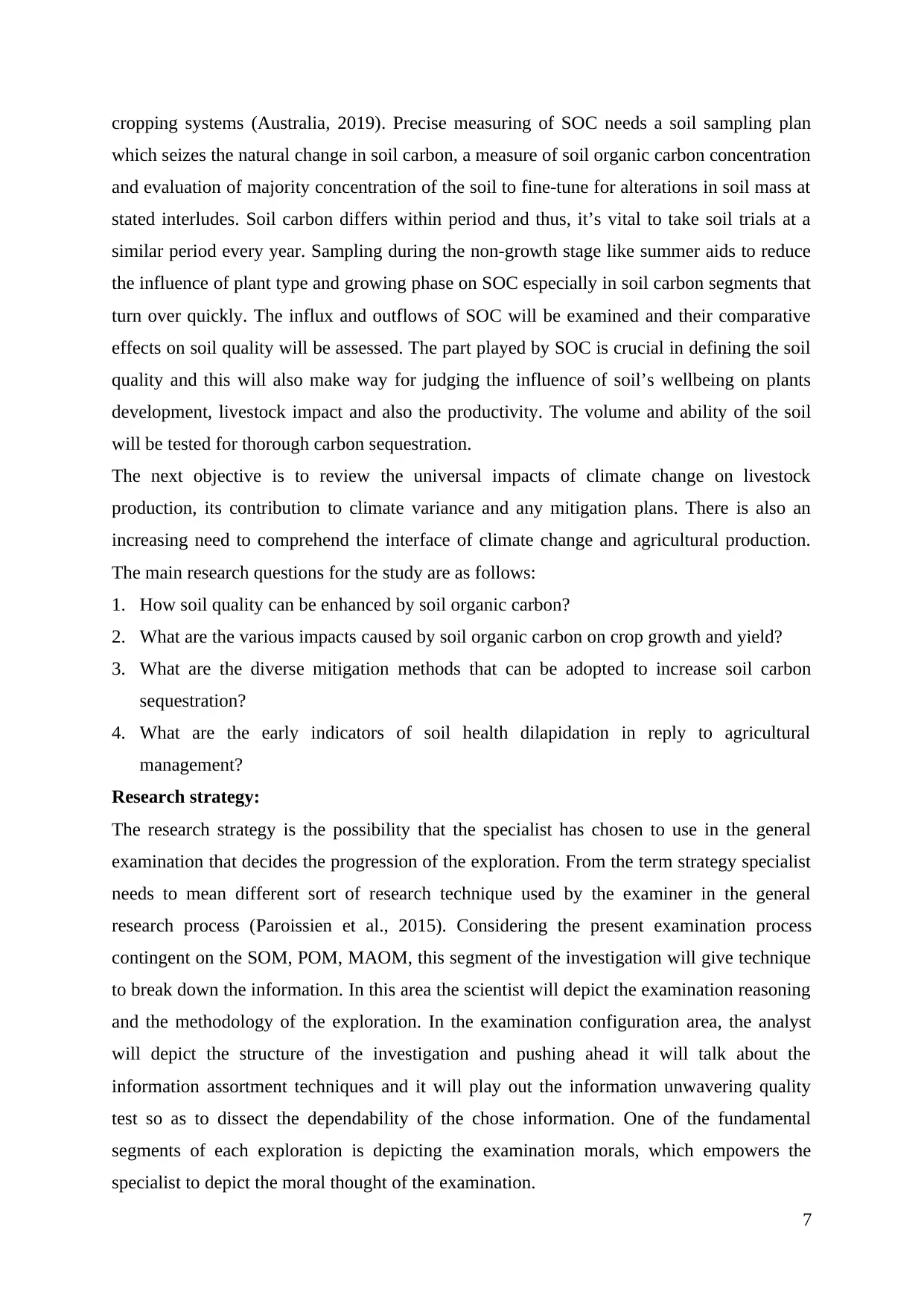
cropping systems (Australia, 2019). Precise measuring of SOC needs a soil sampling plan
which seizes the natural change in soil carbon, a measure of soil organic carbon concentration
and evaluation of majority concentration of the soil to fine-tune for alterations in soil mass at
stated interludes. Soil carbon differs within period and thus, it’s vital to take soil trials at a
similar period every year. Sampling during the non-growth stage like summer aids to reduce
the influence of plant type and growing phase on SOC especially in soil carbon segments that
turn over quickly. The influx and outflows of SOC will be examined and their comparative
effects on soil quality will be assessed. The part played by SOC is crucial in defining the soil
quality and this will also make way for judging the influence of soil’s wellbeing on plants
development, livestock impact and also the productivity. The volume and ability of the soil
will be tested for thorough carbon sequestration.
The next objective is to review the universal impacts of climate change on livestock
production, its contribution to climate variance and any mitigation plans. There is also an
increasing need to comprehend the interface of climate change and agricultural production.
The main research questions for the study are as follows:
1. How soil quality can be enhanced by soil organic carbon?
2. What are the various impacts caused by soil organic carbon on crop growth and yield?
3. What are the diverse mitigation methods that can be adopted to increase soil carbon
sequestration?
4. What are the early indicators of soil health dilapidation in reply to agricultural
management?
Research strategy:
The research strategy is the possibility that the specialist has chosen to use in the general
examination that decides the progression of the exploration. From the term strategy specialist
needs to mean different sort of research technique used by the examiner in the general
research process (Paroissien et al., 2015). Considering the present examination process
contingent on the SOM, POM, MAOM, this segment of the investigation will give technique
to break down the information. In this area the scientist will depict the examination reasoning
and the methodology of the exploration. In the examination configuration area, the analyst
will depict the structure of the investigation and pushing ahead it will talk about the
information assortment techniques and it will play out the information unwavering quality
test so as to dissect the dependability of the chose information. One of the fundamental
segments of each exploration is depicting the examination morals, which empowers the
specialist to depict the moral thought of the examination.
7
which seizes the natural change in soil carbon, a measure of soil organic carbon concentration
and evaluation of majority concentration of the soil to fine-tune for alterations in soil mass at
stated interludes. Soil carbon differs within period and thus, it’s vital to take soil trials at a
similar period every year. Sampling during the non-growth stage like summer aids to reduce
the influence of plant type and growing phase on SOC especially in soil carbon segments that
turn over quickly. The influx and outflows of SOC will be examined and their comparative
effects on soil quality will be assessed. The part played by SOC is crucial in defining the soil
quality and this will also make way for judging the influence of soil’s wellbeing on plants
development, livestock impact and also the productivity. The volume and ability of the soil
will be tested for thorough carbon sequestration.
The next objective is to review the universal impacts of climate change on livestock
production, its contribution to climate variance and any mitigation plans. There is also an
increasing need to comprehend the interface of climate change and agricultural production.
The main research questions for the study are as follows:
1. How soil quality can be enhanced by soil organic carbon?
2. What are the various impacts caused by soil organic carbon on crop growth and yield?
3. What are the diverse mitigation methods that can be adopted to increase soil carbon
sequestration?
4. What are the early indicators of soil health dilapidation in reply to agricultural
management?
Research strategy:
The research strategy is the possibility that the specialist has chosen to use in the general
examination that decides the progression of the exploration. From the term strategy specialist
needs to mean different sort of research technique used by the examiner in the general
research process (Paroissien et al., 2015). Considering the present examination process
contingent on the SOM, POM, MAOM, this segment of the investigation will give technique
to break down the information. In this area the scientist will depict the examination reasoning
and the methodology of the exploration. In the examination configuration area, the analyst
will depict the structure of the investigation and pushing ahead it will talk about the
information assortment techniques and it will play out the information unwavering quality
test so as to dissect the dependability of the chose information. One of the fundamental
segments of each exploration is depicting the examination morals, which empowers the
specialist to depict the moral thought of the examination.
7
Paraphrase This Document
Need a fresh take? Get an instant paraphrase of this document with our AI Paraphraser
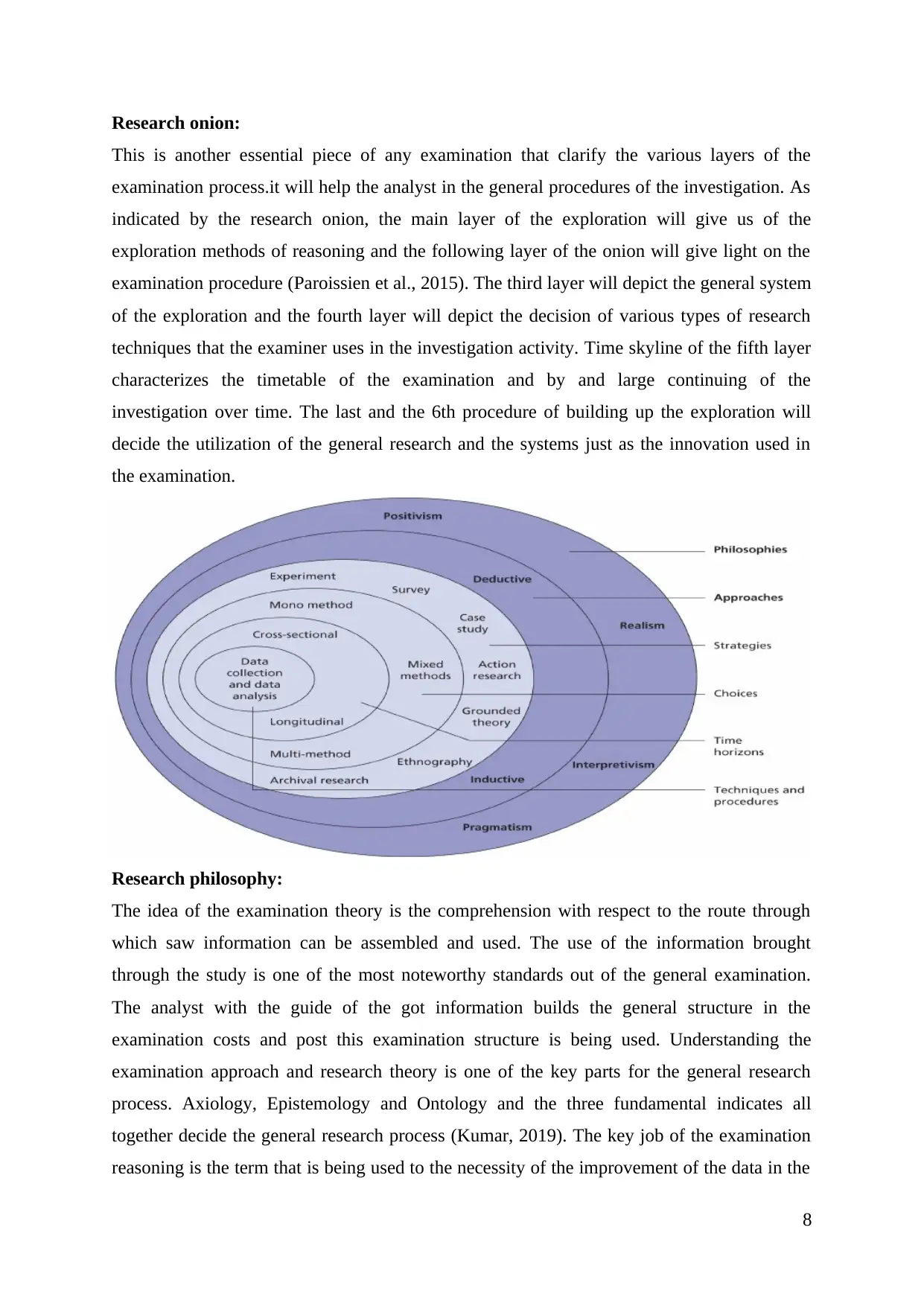
Research onion:
This is another essential piece of any examination that clarify the various layers of the
examination process.it will help the analyst in the general procedures of the investigation. As
indicated by the research onion, the main layer of the exploration will give us of the
exploration methods of reasoning and the following layer of the onion will give light on the
examination procedure (Paroissien et al., 2015). The third layer will depict the general system
of the exploration and the fourth layer will depict the decision of various types of research
techniques that the examiner uses in the investigation activity. Time skyline of the fifth layer
characterizes the timetable of the examination and by and large continuing of the
investigation over time. The last and the 6th procedure of building up the exploration will
decide the utilization of the general research and the systems just as the innovation used in
the examination.
Research philosophy:
The idea of the examination theory is the comprehension with respect to the route through
which saw information can be assembled and used. The use of the information brought
through the study is one of the most noteworthy standards out of the general examination.
The analyst with the guide of the got information builds the general structure in the
examination costs and post this examination structure is being used. Understanding the
examination approach and research theory is one of the key parts for the general research
process. Axiology, Epistemology and Ontology and the three fundamental indicates all
together decide the general research process (Kumar, 2019). The key job of the examination
reasoning is the term that is being used to the necessity of the improvement of the data in the
8
This is another essential piece of any examination that clarify the various layers of the
examination process.it will help the analyst in the general procedures of the investigation. As
indicated by the research onion, the main layer of the exploration will give us of the
exploration methods of reasoning and the following layer of the onion will give light on the
examination procedure (Paroissien et al., 2015). The third layer will depict the general system
of the exploration and the fourth layer will depict the decision of various types of research
techniques that the examiner uses in the investigation activity. Time skyline of the fifth layer
characterizes the timetable of the examination and by and large continuing of the
investigation over time. The last and the 6th procedure of building up the exploration will
decide the utilization of the general research and the systems just as the innovation used in
the examination.
Research philosophy:
The idea of the examination theory is the comprehension with respect to the route through
which saw information can be assembled and used. The use of the information brought
through the study is one of the most noteworthy standards out of the general examination.
The analyst with the guide of the got information builds the general structure in the
examination costs and post this examination structure is being used. Understanding the
examination approach and research theory is one of the key parts for the general research
process. Axiology, Epistemology and Ontology and the three fundamental indicates all
together decide the general research process (Kumar, 2019). The key job of the examination
reasoning is the term that is being used to the necessity of the improvement of the data in the
8
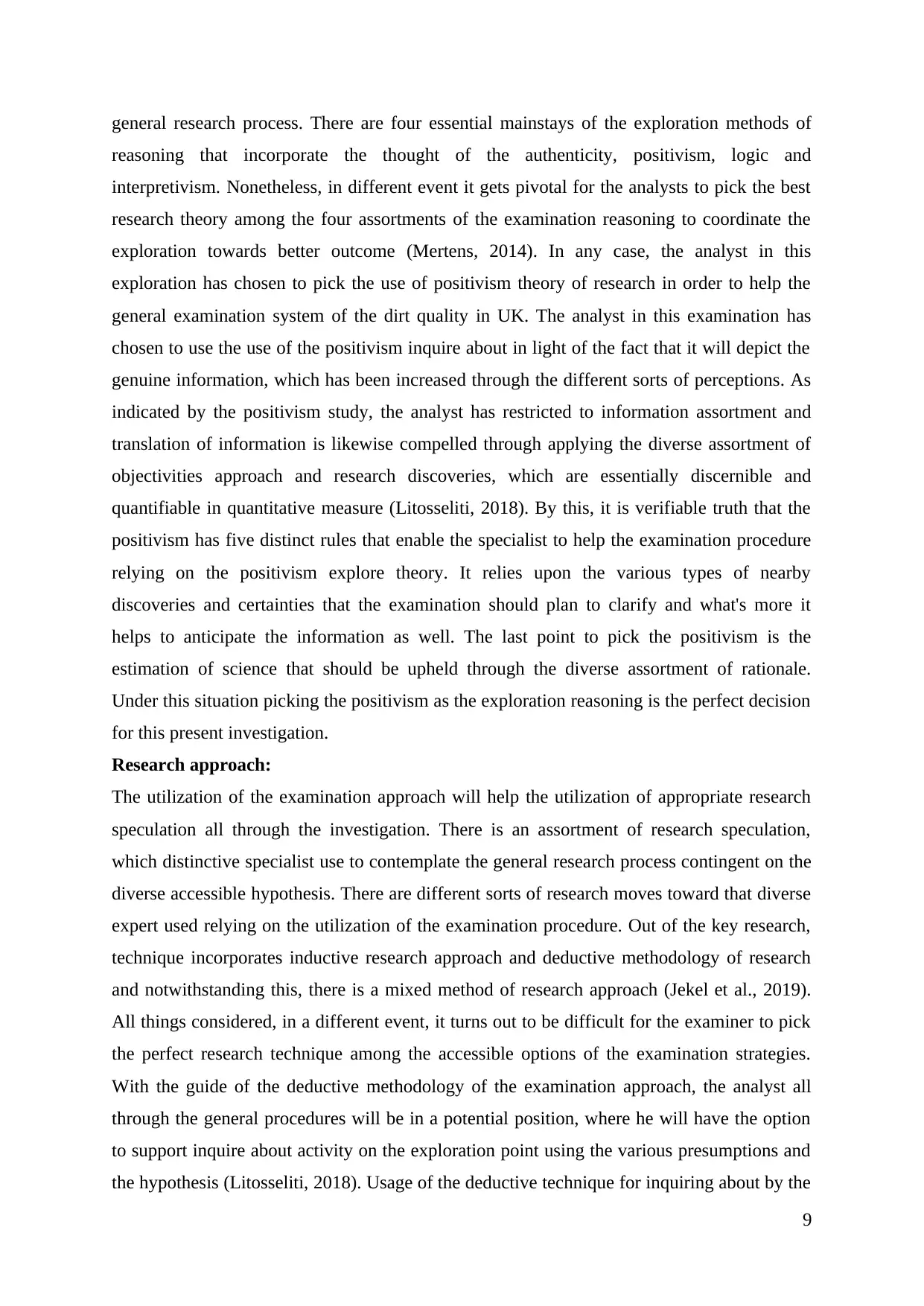
general research process. There are four essential mainstays of the exploration methods of
reasoning that incorporate the thought of the authenticity, positivism, logic and
interpretivism. Nonetheless, in different event it gets pivotal for the analysts to pick the best
research theory among the four assortments of the examination reasoning to coordinate the
exploration towards better outcome (Mertens, 2014). In any case, the analyst in this
exploration has chosen to pick the use of positivism theory of research in order to help the
general examination system of the dirt quality in UK. The analyst in this examination has
chosen to use the use of the positivism inquire about in light of the fact that it will depict the
genuine information, which has been increased through the different sorts of perceptions. As
indicated by the positivism study, the analyst has restricted to information assortment and
translation of information is likewise compelled through applying the diverse assortment of
objectivities approach and research discoveries, which are essentially discernible and
quantifiable in quantitative measure (Litosseliti, 2018). By this, it is verifiable truth that the
positivism has five distinct rules that enable the specialist to help the examination procedure
relying on the positivism explore theory. It relies upon the various types of nearby
discoveries and certainties that the examination should plan to clarify and what's more it
helps to anticipate the information as well. The last point to pick the positivism is the
estimation of science that should be upheld through the diverse assortment of rationale.
Under this situation picking the positivism as the exploration reasoning is the perfect decision
for this present investigation.
Research approach:
The utilization of the examination approach will help the utilization of appropriate research
speculation all through the investigation. There is an assortment of research speculation,
which distinctive specialist use to contemplate the general research process contingent on the
diverse accessible hypothesis. There are different sorts of research moves toward that diverse
expert used relying on the utilization of the examination procedure. Out of the key research,
technique incorporates inductive research approach and deductive methodology of research
and notwithstanding this, there is a mixed method of research approach (Jekel et al., 2019).
All things considered, in a different event, it turns out to be difficult for the examiner to pick
the perfect research technique among the accessible options of the examination strategies.
With the guide of the deductive methodology of the examination approach, the analyst all
through the general procedures will be in a potential position, where he will have the option
to support inquire about activity on the exploration point using the various presumptions and
the hypothesis (Litosseliti, 2018). Usage of the deductive technique for inquiring about by the
9
reasoning that incorporate the thought of the authenticity, positivism, logic and
interpretivism. Nonetheless, in different event it gets pivotal for the analysts to pick the best
research theory among the four assortments of the examination reasoning to coordinate the
exploration towards better outcome (Mertens, 2014). In any case, the analyst in this
exploration has chosen to pick the use of positivism theory of research in order to help the
general examination system of the dirt quality in UK. The analyst in this examination has
chosen to use the use of the positivism inquire about in light of the fact that it will depict the
genuine information, which has been increased through the different sorts of perceptions. As
indicated by the positivism study, the analyst has restricted to information assortment and
translation of information is likewise compelled through applying the diverse assortment of
objectivities approach and research discoveries, which are essentially discernible and
quantifiable in quantitative measure (Litosseliti, 2018). By this, it is verifiable truth that the
positivism has five distinct rules that enable the specialist to help the examination procedure
relying on the positivism explore theory. It relies upon the various types of nearby
discoveries and certainties that the examination should plan to clarify and what's more it
helps to anticipate the information as well. The last point to pick the positivism is the
estimation of science that should be upheld through the diverse assortment of rationale.
Under this situation picking the positivism as the exploration reasoning is the perfect decision
for this present investigation.
Research approach:
The utilization of the examination approach will help the utilization of appropriate research
speculation all through the investigation. There is an assortment of research speculation,
which distinctive specialist use to contemplate the general research process contingent on the
diverse accessible hypothesis. There are different sorts of research moves toward that diverse
expert used relying on the utilization of the examination procedure. Out of the key research,
technique incorporates inductive research approach and deductive methodology of research
and notwithstanding this, there is a mixed method of research approach (Jekel et al., 2019).
All things considered, in a different event, it turns out to be difficult for the examiner to pick
the perfect research technique among the accessible options of the examination strategies.
With the guide of the deductive methodology of the examination approach, the analyst all
through the general procedures will be in a potential position, where he will have the option
to support inquire about activity on the exploration point using the various presumptions and
the hypothesis (Litosseliti, 2018). Usage of the deductive technique for inquiring about by the
9
⊘ This is a preview!⊘
Do you want full access?
Subscribe today to unlock all pages.

Trusted by 1+ million students worldwide
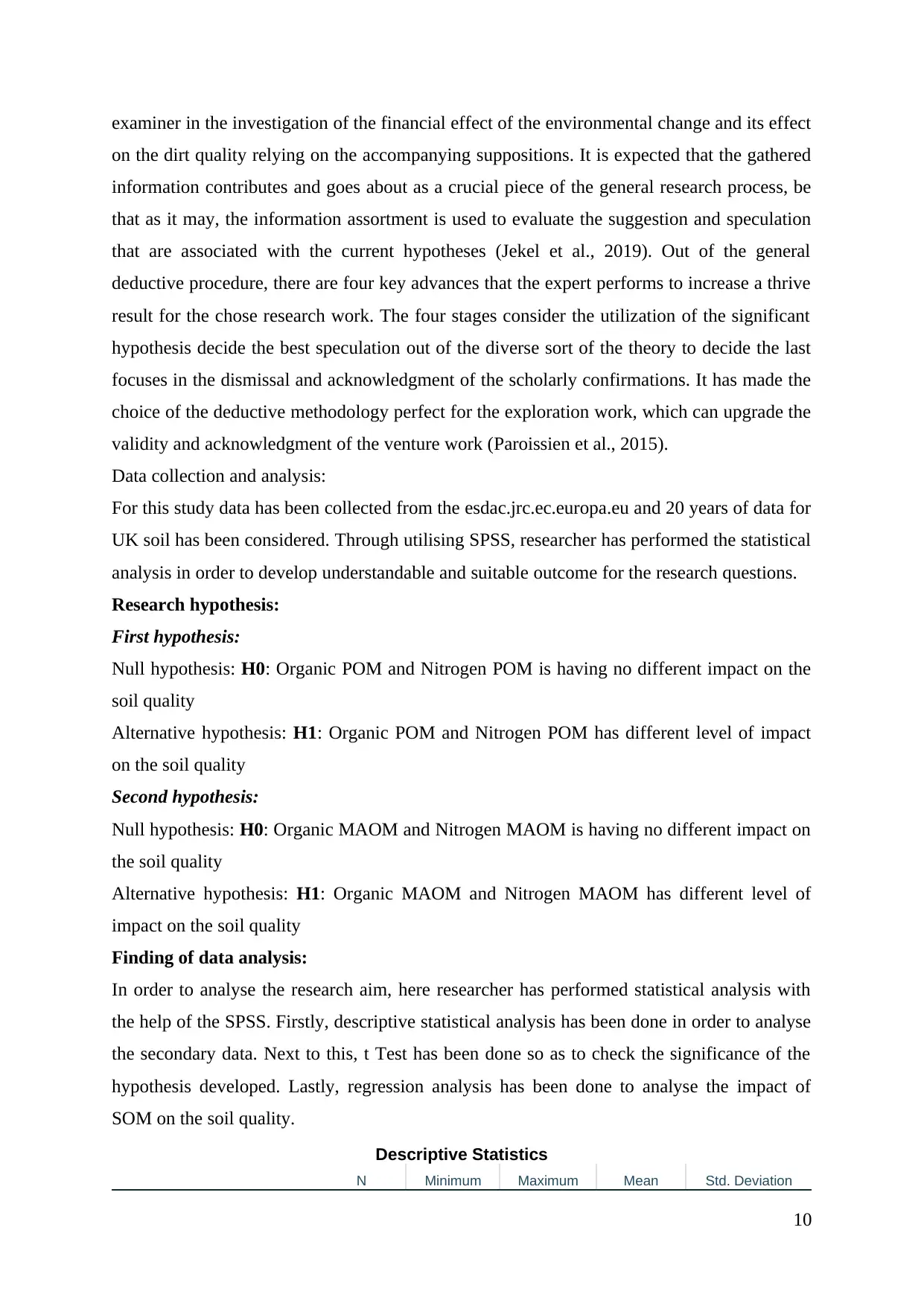
examiner in the investigation of the financial effect of the environmental change and its effect
on the dirt quality relying on the accompanying suppositions. It is expected that the gathered
information contributes and goes about as a crucial piece of the general research process, be
that as it may, the information assortment is used to evaluate the suggestion and speculation
that are associated with the current hypotheses (Jekel et al., 2019). Out of the general
deductive procedure, there are four key advances that the expert performs to increase a thrive
result for the chose research work. The four stages consider the utilization of the significant
hypothesis decide the best speculation out of the diverse sort of the theory to decide the last
focuses in the dismissal and acknowledgment of the scholarly confirmations. It has made the
choice of the deductive methodology perfect for the exploration work, which can upgrade the
validity and acknowledgment of the venture work (Paroissien et al., 2015).
Data collection and analysis:
For this study data has been collected from the esdac.jrc.ec.europa.eu and 20 years of data for
UK soil has been considered. Through utilising SPSS, researcher has performed the statistical
analysis in order to develop understandable and suitable outcome for the research questions.
Research hypothesis:
First hypothesis:
Null hypothesis: H0: Organic POM and Nitrogen POM is having no different impact on the
soil quality
Alternative hypothesis: H1: Organic POM and Nitrogen POM has different level of impact
on the soil quality
Second hypothesis:
Null hypothesis: H0: Organic MAOM and Nitrogen MAOM is having no different impact on
the soil quality
Alternative hypothesis: H1: Organic MAOM and Nitrogen MAOM has different level of
impact on the soil quality
Finding of data analysis:
In order to analyse the research aim, here researcher has performed statistical analysis with
the help of the SPSS. Firstly, descriptive statistical analysis has been done in order to analyse
the secondary data. Next to this, t Test has been done so as to check the significance of the
hypothesis developed. Lastly, regression analysis has been done to analyse the impact of
SOM on the soil quality.
Descriptive Statistics
N Minimum Maximum Mean Std. Deviation
10
on the dirt quality relying on the accompanying suppositions. It is expected that the gathered
information contributes and goes about as a crucial piece of the general research process, be
that as it may, the information assortment is used to evaluate the suggestion and speculation
that are associated with the current hypotheses (Jekel et al., 2019). Out of the general
deductive procedure, there are four key advances that the expert performs to increase a thrive
result for the chose research work. The four stages consider the utilization of the significant
hypothesis decide the best speculation out of the diverse sort of the theory to decide the last
focuses in the dismissal and acknowledgment of the scholarly confirmations. It has made the
choice of the deductive methodology perfect for the exploration work, which can upgrade the
validity and acknowledgment of the venture work (Paroissien et al., 2015).
Data collection and analysis:
For this study data has been collected from the esdac.jrc.ec.europa.eu and 20 years of data for
UK soil has been considered. Through utilising SPSS, researcher has performed the statistical
analysis in order to develop understandable and suitable outcome for the research questions.
Research hypothesis:
First hypothesis:
Null hypothesis: H0: Organic POM and Nitrogen POM is having no different impact on the
soil quality
Alternative hypothesis: H1: Organic POM and Nitrogen POM has different level of impact
on the soil quality
Second hypothesis:
Null hypothesis: H0: Organic MAOM and Nitrogen MAOM is having no different impact on
the soil quality
Alternative hypothesis: H1: Organic MAOM and Nitrogen MAOM has different level of
impact on the soil quality
Finding of data analysis:
In order to analyse the research aim, here researcher has performed statistical analysis with
the help of the SPSS. Firstly, descriptive statistical analysis has been done in order to analyse
the secondary data. Next to this, t Test has been done so as to check the significance of the
hypothesis developed. Lastly, regression analysis has been done to analyse the impact of
SOM on the soil quality.
Descriptive Statistics
N Minimum Maximum Mean Std. Deviation
10
Paraphrase This Document
Need a fresh take? Get an instant paraphrase of this document with our AI Paraphraser
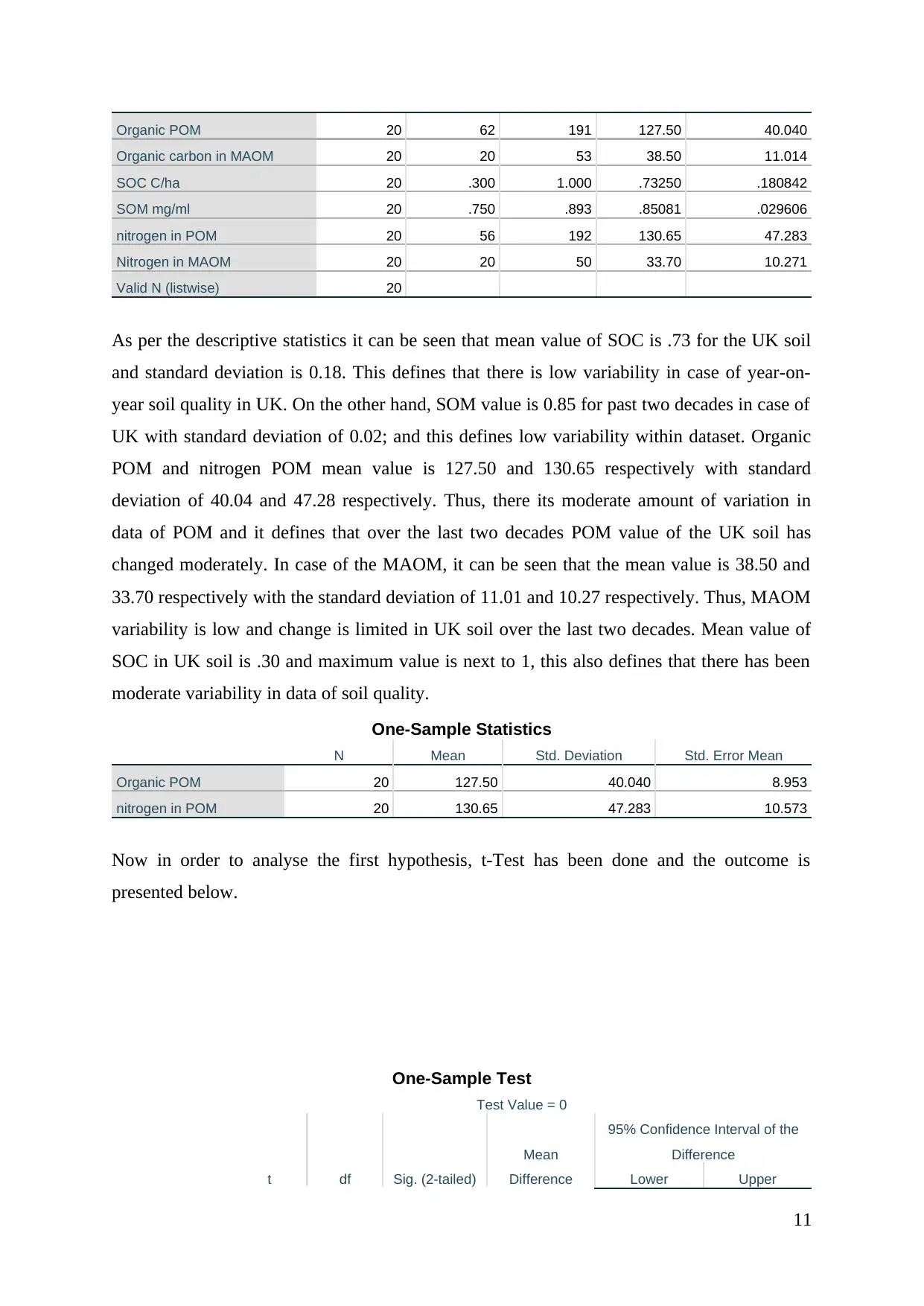
Organic POM 20 62 191 127.50 40.040
Organic carbon in MAOM 20 20 53 38.50 11.014
SOC C/ha 20 .300 1.000 .73250 .180842
SOM mg/ml 20 .750 .893 .85081 .029606
nitrogen in POM 20 56 192 130.65 47.283
Nitrogen in MAOM 20 20 50 33.70 10.271
Valid N (listwise) 20
As per the descriptive statistics it can be seen that mean value of SOC is .73 for the UK soil
and standard deviation is 0.18. This defines that there is low variability in case of year-on-
year soil quality in UK. On the other hand, SOM value is 0.85 for past two decades in case of
UK with standard deviation of 0.02; and this defines low variability within dataset. Organic
POM and nitrogen POM mean value is 127.50 and 130.65 respectively with standard
deviation of 40.04 and 47.28 respectively. Thus, there its moderate amount of variation in
data of POM and it defines that over the last two decades POM value of the UK soil has
changed moderately. In case of the MAOM, it can be seen that the mean value is 38.50 and
33.70 respectively with the standard deviation of 11.01 and 10.27 respectively. Thus, MAOM
variability is low and change is limited in UK soil over the last two decades. Mean value of
SOC in UK soil is .30 and maximum value is next to 1, this also defines that there has been
moderate variability in data of soil quality.
One-Sample Statistics
N Mean Std. Deviation Std. Error Mean
Organic POM 20 127.50 40.040 8.953
nitrogen in POM 20 130.65 47.283 10.573
Now in order to analyse the first hypothesis, t-Test has been done and the outcome is
presented below.
One-Sample Test
Test Value = 0
t df Sig. (2-tailed)
Mean
Difference
95% Confidence Interval of the
Difference
Lower Upper
11
Organic carbon in MAOM 20 20 53 38.50 11.014
SOC C/ha 20 .300 1.000 .73250 .180842
SOM mg/ml 20 .750 .893 .85081 .029606
nitrogen in POM 20 56 192 130.65 47.283
Nitrogen in MAOM 20 20 50 33.70 10.271
Valid N (listwise) 20
As per the descriptive statistics it can be seen that mean value of SOC is .73 for the UK soil
and standard deviation is 0.18. This defines that there is low variability in case of year-on-
year soil quality in UK. On the other hand, SOM value is 0.85 for past two decades in case of
UK with standard deviation of 0.02; and this defines low variability within dataset. Organic
POM and nitrogen POM mean value is 127.50 and 130.65 respectively with standard
deviation of 40.04 and 47.28 respectively. Thus, there its moderate amount of variation in
data of POM and it defines that over the last two decades POM value of the UK soil has
changed moderately. In case of the MAOM, it can be seen that the mean value is 38.50 and
33.70 respectively with the standard deviation of 11.01 and 10.27 respectively. Thus, MAOM
variability is low and change is limited in UK soil over the last two decades. Mean value of
SOC in UK soil is .30 and maximum value is next to 1, this also defines that there has been
moderate variability in data of soil quality.
One-Sample Statistics
N Mean Std. Deviation Std. Error Mean
Organic POM 20 127.50 40.040 8.953
nitrogen in POM 20 130.65 47.283 10.573
Now in order to analyse the first hypothesis, t-Test has been done and the outcome is
presented below.
One-Sample Test
Test Value = 0
t df Sig. (2-tailed)
Mean
Difference
95% Confidence Interval of the
Difference
Lower Upper
11
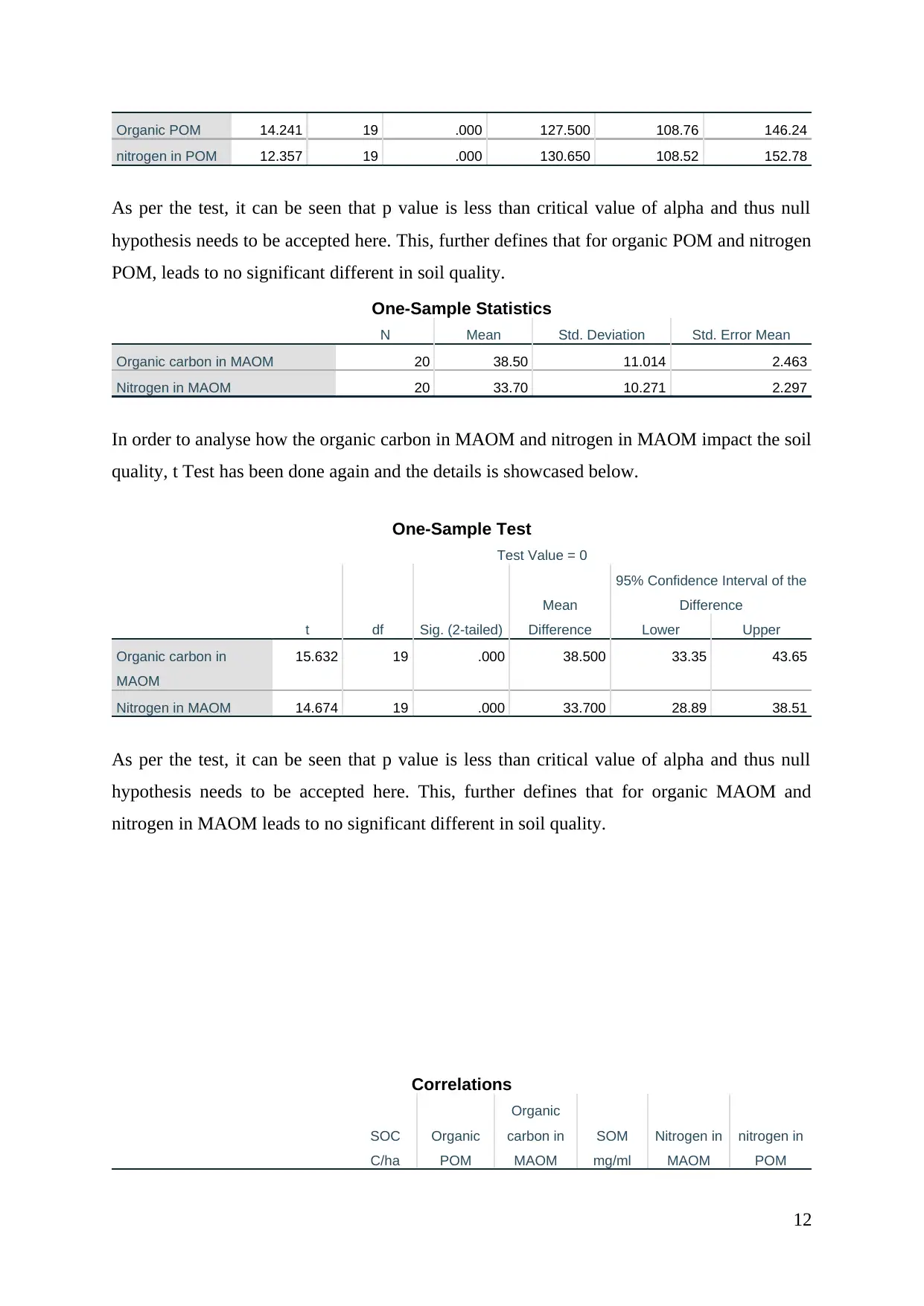
Organic POM 14.241 19 .000 127.500 108.76 146.24
nitrogen in POM 12.357 19 .000 130.650 108.52 152.78
As per the test, it can be seen that p value is less than critical value of alpha and thus null
hypothesis needs to be accepted here. This, further defines that for organic POM and nitrogen
POM, leads to no significant different in soil quality.
One-Sample Statistics
N Mean Std. Deviation Std. Error Mean
Organic carbon in MAOM 20 38.50 11.014 2.463
Nitrogen in MAOM 20 33.70 10.271 2.297
In order to analyse how the organic carbon in MAOM and nitrogen in MAOM impact the soil
quality, t Test has been done again and the details is showcased below.
One-Sample Test
Test Value = 0
t df Sig. (2-tailed)
Mean
Difference
95% Confidence Interval of the
Difference
Lower Upper
Organic carbon in
MAOM
15.632 19 .000 38.500 33.35 43.65
Nitrogen in MAOM 14.674 19 .000 33.700 28.89 38.51
As per the test, it can be seen that p value is less than critical value of alpha and thus null
hypothesis needs to be accepted here. This, further defines that for organic MAOM and
nitrogen in MAOM leads to no significant different in soil quality.
Correlations
SOC
C/ha
Organic
POM
Organic
carbon in
MAOM
SOM
mg/ml
Nitrogen in
MAOM
nitrogen in
POM
12
nitrogen in POM 12.357 19 .000 130.650 108.52 152.78
As per the test, it can be seen that p value is less than critical value of alpha and thus null
hypothesis needs to be accepted here. This, further defines that for organic POM and nitrogen
POM, leads to no significant different in soil quality.
One-Sample Statistics
N Mean Std. Deviation Std. Error Mean
Organic carbon in MAOM 20 38.50 11.014 2.463
Nitrogen in MAOM 20 33.70 10.271 2.297
In order to analyse how the organic carbon in MAOM and nitrogen in MAOM impact the soil
quality, t Test has been done again and the details is showcased below.
One-Sample Test
Test Value = 0
t df Sig. (2-tailed)
Mean
Difference
95% Confidence Interval of the
Difference
Lower Upper
Organic carbon in
MAOM
15.632 19 .000 38.500 33.35 43.65
Nitrogen in MAOM 14.674 19 .000 33.700 28.89 38.51
As per the test, it can be seen that p value is less than critical value of alpha and thus null
hypothesis needs to be accepted here. This, further defines that for organic MAOM and
nitrogen in MAOM leads to no significant different in soil quality.
Correlations
SOC
C/ha
Organic
POM
Organic
carbon in
MAOM
SOM
mg/ml
Nitrogen in
MAOM
nitrogen in
POM
12
⊘ This is a preview!⊘
Do you want full access?
Subscribe today to unlock all pages.

Trusted by 1+ million students worldwide
1 out of 19
Related Documents
Your All-in-One AI-Powered Toolkit for Academic Success.
+13062052269
info@desklib.com
Available 24*7 on WhatsApp / Email
![[object Object]](/_next/static/media/star-bottom.7253800d.svg)
Unlock your academic potential
Copyright © 2020–2025 A2Z Services. All Rights Reserved. Developed and managed by ZUCOL.





